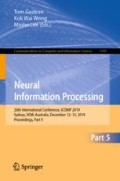Abstract
Phase change memory (PCM) is arguably one of the most promising non-volatile memories which can be used in neuromorphic applications. When we use PCM as analog synaptic elements, non-ideality impact should be carefully taken into account. In this paper, we investigate the impact of such non-ideality items as nonlinear weight update and resistance drift on training accuracy in a spiking restricted Boltzmann machine (RBM). In addition to ideal PCM model, actual measurement-based PCM characteristics is used for this study. The resistance drift affects training accuracy, especially in a widely distributed read interval time caused by spatial and temporal sparse spike activities during training in spiking RBM. Our simulation results show that the training accuracy worsens with the increase of the weight-update nonlinearity or the resistance-drift coefficient. However, the results also suggest we can expect more than 8.95% improvement in training accuracy. This potential improvement will be possible if we use linearity-improved confined PCM cells whose median resistance drift coefficient is 0.005, compared to the resistance drift coefficient of more than 0.02 in typical existing PCM cells.
Access this chapter
Tax calculation will be finalised at checkout
Purchases are for personal use only
References
Burr, G.W., et al.: Neuromorphic computing using non-volatile memory. Adv. Phys. X 2(1), 89–124 (2017)
Tsai, H., et al.: Recent progress in analog memory-based accelerators for deep learning. J. Phys. D: Appl. Phys. 51 (2018). 283001
Ambrogio, S., et al.: Equivalent-accuracy accelerated neural-network training using analogue memory. Nature 558, 60–67 (2018)
Sebastian, A., et al.: Tutorial: brain-inspired computing using phase-change memory devices. J. Appl. Phys. 124 (2018). 111101
Mochida, R., et al.: A 4M synapses integrated analog ReRAM based 66.5 TOPS/W neural-network processor with cell current controlled writing and flexible network architecture. In: IEEE Symposium on VLSI Technology (2018)
Yue, K., et al.: A brain-plausible neuromorphic on-the-fly learning system implemented with magnetic domain wall analog memristors. Sci. Adv. 5(4) (2019). eaau8170. https://doi.org/10.1126/sciadv.aau8170
Lin, Y.-H., et al.: Performance impacts of analog ReRAM non-ideality on neuromorphic computing. IEEE Trans. Electron Devices 66(3), 1289–1295 (2019)
Ernoult, M., et al.: Using memristors for robust local learning of hardware restricted Boltzmann machines. Sci. Rep. 9 (2019). Article number 1851
Kim, S., et al.: NVM neuromorphic core with 64k-cell (256-by-256) phase change memory synaptic array with on-chip neuron circuits for continuous in-situ learning. In: IEDM (2015)
Suri, M., et al.: Phase change memory as synapse for ultra-dense neuromorphic systems: application to complex visual pattern extraction. In: IEDM (2011)
Merolla, P.A., et al.: A million spiking neuron integrated circuit with a scalable communication network and interface. Science 345(6197), 668–673 (2014)
Davies, M., et al.: IEEE Micro 38(1), 82–99 (2018)
Boybat, I., et al.: Neuromorphic computing with multi-memristive synapses. Nature Commun. 9 (2018). Article number 2514
Suri, M., et al.: Impact of PCM resistance-drift in neuromorphic systems and drift-mitigation strategy. In: IEEE/ACM International Symposium on Nanoscale Architectures (2013)
Nomura, A., et al.: NVM weight variation impact on analog spiking neural network chip. In: Cheng, L., Leung, A.C.S., Ozawa, S. (eds.) ICONIP 2018. LNCS, vol. 11307, pp. 676–685. Springer, Cham (2018). https://doi.org/10.1007/978-3-030-04239-4_61
Nandakumar, S.R., et al.: A phase-change memory model for neuromorphic computing. J. Appl. Phys. 124 (2018). 152135
Neftci, E., et al.: Event-driven contrastive divergence for spiking neuromorphic systems. Front. Neurosci. 7, 272 (2014)
Bichler, O., et al.: Visual pattern extraction using energy-efficient “2-PCM synapse” neuromorphic architecture. IEEE Trans. Electron Devices 59(8), 2206–2214 (2012)
Ito, M., et al.: Lightweight refresh method for PCM-based neuromorphic circuits. In: 18th International Conference on Nanotechnology, pp. 1–4. IEEE (2018)
Kim, W., et al.: Confined PCM-based analog synaptic devices offering low resistance-drift and 1000 programmable states for deep learning. In: IEEE Symposium on VLSI technology (2019)
Boybat, I., et al.: Stochastic weight updates in phase-change memory-based synapses and their influence on artificial neural networks. In: 13th Conference on Ph.D. Research in Microelectronics and Electronics (PRIME) (2017)
Author information
Authors and Affiliations
Corresponding author
Editor information
Editors and Affiliations
Rights and permissions
Copyright information
© 2019 Springer Nature Switzerland AG
About this paper
Cite this paper
Ishii, M. et al. (2019). Performance Analysis of Spiking RBM with Measurement-Based Phase Change Memory Model. In: Gedeon, T., Wong, K., Lee, M. (eds) Neural Information Processing. ICONIP 2019. Communications in Computer and Information Science, vol 1143. Springer, Cham. https://doi.org/10.1007/978-3-030-36802-9_63
Download citation
DOI: https://doi.org/10.1007/978-3-030-36802-9_63
Published:
Publisher Name: Springer, Cham
Print ISBN: 978-3-030-36801-2
Online ISBN: 978-3-030-36802-9
eBook Packages: Computer ScienceComputer Science (R0)

